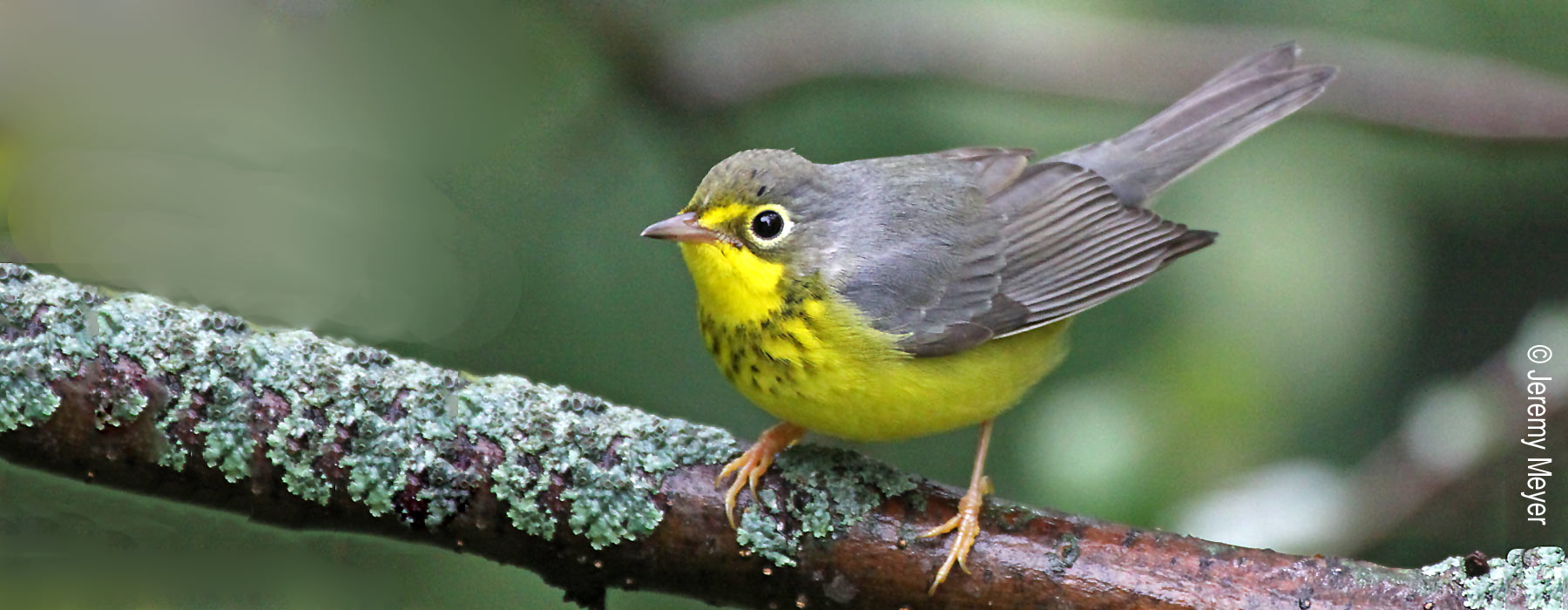Canada Warblers are declining throughout the Northeast at rates of 4% to 7% per year. Although the causes of the declines are unknown, VCE's forest bird work is helping to find some answers.
Loss and degradation of breeding habitat appear to be contributing factors. VCE continues to monitor Canada Warbler population trends in the Northeast with our Vermont Forest Bird Monitoring Program and the National Park Landbird Monitoring Program. We have reviewed available information on Canada Warbler habitat use and introduced new findings that relate habitat characteristics to reproductive success. We have also produced a pamphlet explaining a variety of land protection and forest management strategies to help stabilize declining Canada Warbler populations.
Canada Warbler News
 January 01, 2010
January 01, 2010
Canada Warbler Population Trends Down in Canada
The Canadian Breeding Bird Survey (BBS) indicates a steady population decrease from about 1970 to the present, with an overall loss of 70% of the population. more » August 01, 2008
August 01, 2008
Vermont Breeding Bird Survey Shows Losses for Canada Warbler Range
Canada Warbler breeding detections decreased by 31% (142 to 98 blocks) from the first atlas completed in the early 1980s to the second atlas completed in 2007. more »Canada Warbler densities are naturally highest in swamps and riparian forests with a well-developed shrub layer. Moderate numbers occur in old upland forests, especially in association with canopy gaps. Small openings created by timber harvest may enhance Canada Warbler habitat, but more research is needed to identify a minimum gap size. Even-aged forests between 20 and 75 years old seem to be of low value to this species. Intensive harvest of upland forest may reduce Canada Warbler abundance in the short term. However, high densities occur 5-20 years following harvest operations, especially in areas where some overstory trees are retained. A similar, though somewhat muted, response is observed in areas that are completely clearcut. Saplings in the 2-6 m height class are a key habitat feature in timber cuts and in natural settings, therefore removal of shrubs and saplings by thinning or deer browse reduces habitat value. Canada Warblers inhabit deciduous and coniferous forests, but tend to be more abundant in mixed forests than in pure stands. The species requires large forested tracts for breeding in settled landscapes, but is not area-sensitive in forest-dominated regions.
A recent study indicated that Canada Warblers nesting in regenerating harvest zones achieve levels of pairing and fledging success similar to those breeding in forested wetlands. The wet forest was more productive overall, because small and overlapping territories enabled the species to breed in relatively high densities. The small size and packed configuration of wetland territories could indicate higher resource availability in some wet forests, compared to upland timber cuts.
Natural resource professionals can use a variety of land protection and forest management strategies to help stabilize declining Canada Warbler populations. Land protection efforts aimed at conserving Canada Warbler habitat should focus on large areas of moist, mixed forest that feature a semi-open canopy and dense undergrowth. Stewards of managed forests could employ a variety of strategies to support this species, including efforts to maintain understory and forest- floor structure, riparian and wetland buffers, mixed forest cover, and large forest reserves in which treefall gaps naturally occur. Upland clearcutting with residual tree retention seems to improve Canada Warbler habitat during a 15-year period beginning about 5 years after harvest. Partial cuts, like those used in a shelterwood system, also appear to benefit the species. We suggest that future investigations collect standardized density and demographic data to compare the quality of natural and human-created habitats and evaluate effects of small-scale harvests on Canada Warbler populations.
REPORTS AND PUBLICATIONS
Download the complete technical report – Canada Warbler Population Status, Habitat Use, and Stewardship Guidelines for Northeastern Forests
Download the pamphlet – Conserving Canada Warbler Habitat: Practical Guidelines for Stewards of the Northern Forest
Chace, J.F., S.D. Faccio and A. Chacko. 2009. Canada Warbler habitat use of Northern Hardwoods in Vermont. Northeastern Naturalist 16(4): 491-500.
Hallworth, M., P. M. Benham, J. D. Lambert and L. Reitsma. 2008. Canada warbler (Wilsonia canadensis) breeding ecology in young forest stands compared to a red maple (Acer rubrum) swamp. Forest Ecology and Management 255: 1353-1358.
Hallworth, M., A. Ueland, E. Anderson, J. D. Lambert, L. Reitsma. 2008. Habitat Selection and Site Fidelity of Canada Warblers (Wilsonia canadensis) in Central New Hampshire. Auk 125(4): 880-888.

